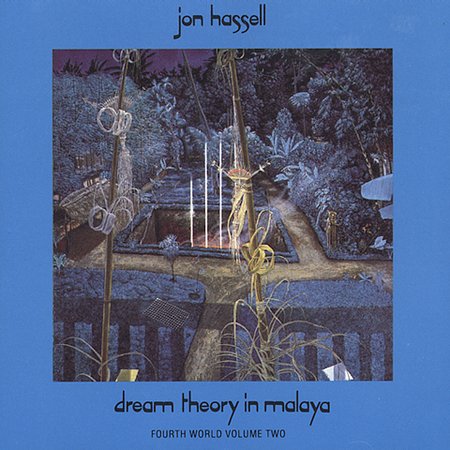- Dream Theory in Malaya
Infobox Album |
Name = Dream Theory in Malaya
Type =Album
Artist =Jon Hassell

Released = 1981
Recorded = Grant Avenue Studio, Ontario, 1981
Genre = World
Length = 36:25
Label = EG, Caroline
Producer =Jon Hassell
Reviews =Allmusic Rating|3|5 [http://www.allmusic.com/cg/amg.dll?p=amg&sql=10:47120roar48n link]
|
Last album = "Possible Musics " (1980)
This album = "Dream Theory in Malaya" (1981)
Next album = "Aka-Darbari-Java (Magic Realism)" (1983)"Dream Theory in Malaya : Fourth World Volume Two" is a
World music album byJon Hassell , released in 1981. It is the "sequel" to his collaboration withBrian Eno , "Fourth World Vol. 1 :Possible Musics ", which was released the previous year.Overview
Hassell got the idea for the album after reading a paper by anthropologist / adventurer-ethnologist Kilton Stewart about the
Senoi , an aboriginal tribe he first visited in 1935, who lived in the highlands of Malay (as it was known before the present state ofMalaysia was constructed).The "Senoi" culture, he discovered, regarded dreams as an important part of life. Mornings were used by families to indulge in the custom of dream-telling, where, for instance, a "child's fearful dream of falling was praised as a gift to learn to fly the next night". Songs and dances learned in dreams were often taught to neighbouring tribes to foster good relations.
One of the tribes who lived nearby in the swamp regions, the "Semelai", practiced the art of splashing water with the hands to form a rhythmic music. Hassell heard recordings of this on a
BBC publication - a book ("Primitive Peoples") which was accompanied by a vinyl record - and used it as "a thematic guide for the entire recording", especially the track "Malay", "the centerpiece of the record".Track listing
# Chor Moiré — 2:21
# Courage — 3:38
# Dream Theory — 5:15
# Datu Bintung at Jelong — 7:05
# Malay — 10:12
# These Times... — 2:53
# Gift of Fire — 5:01(An early 80's EG cassette also included an extra track, "Ordinary Mind" (2:58), located bewteen "Datu Bintung at Jelong" and "Malay".)
The music
The album was recorded at Grant Avenue Studio,
Hamilton, Ontario , Canada, with the engineering and production help of Bob and Daniel Lanois.Hassell would experiment with "musical sketches" in the basement studio of Michael Brook's house in Toronto, who was helping him to coordinate the recording, and from there he'd commute to Grant Avenue and put things down on multitrack, along with Brian Eno who was also there. Eno's main input on the sessions was playing drums and bells on "Courage," "Dream Theory," and "These Times". These sessions also marked Hassel's first associations with Lanois and Brook.
He spent a lot of time on an "invented exotic scale on top of a tambura-like drone consisting of a set of sine tones that I've tuned as a guide to keep me on the Indonesian-type tuning that nobody ever tried to play on a trumpet before". As in the previous album, "
Possible Musics ", his trumpet is mixed and looped and stretched so that it never really sounds like a trumpet at all.Track 1 features digital delay, which at the time was a relatively new studio process, and is composed of rhythmic loops, short trumpet blasts and sharp intonations. Tracks 2 and 3 share a raspy, treated, looped trumpet riff, with "3" employing waves of overdubs, bass and pottery drums. Track 4 is based on a background of gongs and drums over which a breathy, distorted trumpet drones and blasts. The longest track, 5, features the "splash" rhythms mentioned above, along with
Raga -style percussion, gongs, the sounds of giggling children, and an over-riding lead trumpet. Track 6 is the most "ambient" of all, being mostly chimes/gongs and birdsong. The last track has a background of distorted trumpet waves and agamelan -style beat.Credits
* Produced, and all titles, by Jon Hassell
* Cover painting : "Alexander's Dream", byMati Klarwein [http://www.matiklarweinart.com/en/gallery/alexanders-dream-1980.htm 1]
* Jon Hassell : trumpet, pottery drums, Prophet 5, bowl gongs
* Brian Eno : drums, bowl gongs & bells
*Michael Brook : bass
*Miguel Frasconi : bowl gongs
* Walter DeMaria : distant drum
*Daniel Lanois : mix, engineering
* Greg Roberts : additional engineering
* Paul Fitzgerald : splash rhythm edit assist
* Andrew Timar : frog bog recording
* Jimmy de Sana : photo
* Paula Greif : designVersions
External links
* [http://www.jonhassell.com/dream.html Homepage album entry]
* [http://www.jonhassell.abelgratis.co.uk/HTML/soundon.html Interview; "Sound On Sound", 1991]
* [http://www.furious.com/perfect/hassell.html Interview; "Perfect Sound Forever", July 1997]
* [http://www.hungryghost.net/PPN/Hassell.htm Interview; "Hungry Ghost"]
* [http://www.progreviews.com/reviews/display.php?rev=jh-dtim "Ground & Sky" review]
* [http://www.connollyco.com/discography/jon_hassell/dream.html "ConnolyCo" review]
* [http://www.grantavestudio.com/ Studio homepage]
* Information on Kilton Stewart, theSenoi , and their dreams : [http://www.dr-dream.com/kilton.htm 1] , [http://www.spiritwatch.ca/senoi.htm 2] , [http://psych.ucsc.edu/dreams/Library/senoi3.html 3] , [http://www.shpm.com/qa/qadream/qadream8.html 4] , [http://www.angelfire.com/ak/electricdreams/senoi.htm 5] , [http://psych.ucsc.edu/dreams/Library/senoi.html 6]
Brian Eno
Wikimedia Foundation. 2010.
